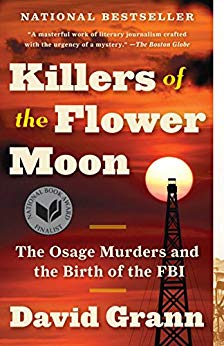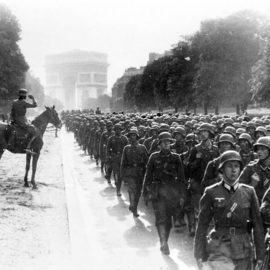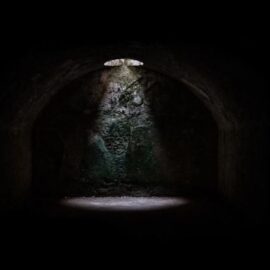

This article is an excerpt from the Shortform summary of "Killers of the Flower Moon" by David Grann. Shortform has the world's best summaries of books you should be reading.
Like this article? Sign up for a free trial here .
Who was Burt Lawson? What was his role in the Osage murder conspiracy?
Burt Lawson claimed responsibility for the explosion that killed Osage woman Rita Smith and her husband Bill Smith. Lawson confessed to following the orders of William Hale, and his confession offered a substantial break in the case.
Continue reading to learn more about Burt Lawson and this tragic episode in American history.
Burt Lawson’s Confession Leads to William Hale
In October 1925, investigator Tom White received a new tip, this time from a prisoner in the Oklahoma state penitentiary named Burt Lawson. Lawson claimed that his wife had carried on an affair with Bill Smith, while he had been working as Smith’s ranch hand. His jealousy and bitterness toward Bill Smith had made him an easy target when the Hale conspiracy came to recruit him.
Lawson claimed that, in early 1921, Ernest Burkhart and William Hale had offered him $5,000 to place the fuse under the Smith house that set off the explosion. Hale had even provided him with the tools for making the bomb, including the nitroglycerin and the coiled fuse. Burt Lawson, after some pressure from Hale, agreed to set up the explosive device and detonate it. He had waited until he was sure Bill and Rita were asleep and then lit the fuse, watching the house blow up.
This was a genuine break in the case, a confession from an eyewitness who could directly implicate Hale. But White knew he had to act quickly because Hale’s murderous plot was getting closer and closer to succeeding. Mollie Burkhart was getting sicker and sicker, with the Shoun brothers’ “treatment” of her diabetes only making her condition worse. It seemed just a matter of time before she died, leaving her headright—and the accumulated headrights of all the other Osage murder victims—in her husband Ernest’s possession, in which position Hale would easily be able to exploit them. Mollie desperately needed to be moved to a hospital, away from the Shoun brothers and away from the machinations of her husband and his family.
In January 1926, U.S. Marshals arrested Ernest Burkhart. Hale, meanwhile, confidently and politely strolled into the county sheriff’s office to surrender. In conversations with reporters after being taken into custody, Hale was cordial and polite but refused to discuss anything about the case.
White knew that he needed to “break” Ernest and get him to turn on his uncle. Without a confession from Ernest, his case was weak—all he had was jailhouse testimony from Burt Lawson, who may well have been lying. Things got worse when Hale’s attorneys produced a telegram signed by Hale in Texas at the time of the Smith bombing, proving that he couldn’t have been in Osage County at the time. This was a serious threat to the case and a potential source of major embarrassment for the Bureau. And J. Edgar Hoover would undoubtedly take out his wrath on White if the case collapsed.
The Plot Revealed
In his quest to shore up the case, White turned to the man who had caused so much grief and embarrassment for the Bureau during its original investigation: the outlaw Blackie Thompson. Blackie Thompson had been released from prison by the Bureau in 1923 to work undercover and help solve the Osage murders. Instead, Blackie had gone on a criminal rampage, robbing a bank and slaying a police officer. By 1926, he was back in prison.
But White suspected that, for all his misdeeds and the Bureau’s disastrous bungling, Blackie really did have valuable information. So he arranged to have Blackie transferred to the federal prison in Guthrie, Oklahoma where he could be interrogated. White’s team told Blackie that his cooperation would not result in any reduction of his current prison sentence—thus, eliminating much of the convict’s incentive to lie. Upon questioning, Blackie revealed to federal agents that Hale and Burkhart had engaged him and the now-deceased Curley Johnson to murder Bill and Rita Smith. The only reason Blackie had never gone through with it was that he had been arrested and imprisoned for car theft before he had the chance to participate in the plot.
The agents used Blackie’s account to break Ernest Burkhart. They dramatically brought the two together in a room at the jail where Burkhart was being held, where Blackie told Ernest that he had shared everything he knew with the agents. Ernest was clearly scared and defeated. He finally confessed to White, admitting that Hale had tasked him with recruiting the operatives to blow up the Smith house. Burkhart said that Asa Kirby (recruited through the bootlegger Henry Grammer) had actually made the bomb and ignited the fuse, not Burt Lawson—Lawson, like so many jailhouse informants throughout the case, likely in the hopes of getting his sentence reduced. He also revealed that Hale had traveled with Grammer to Texas on the day of the bombing, with the express purpose of manufacturing an alibi.
Ernest also linked Hale directly to the murder of Henry Roan, stating that a contract killer named John Ramsey (another associate of Grammer) had been hired to kill him. Agents in the field immediately apprehended Ramsey, brought him into custody, and presented him with Burkhart’s signed confession. Ramsey, in turn, confessed to getting Roan drunk and shooting him in the back of the head.
Ernest, finally, gave key information about the murder of Anna Brown. He said that the mysterious “third man” spotted with Anna and his brother, Bryan Burkhart, on the last night Anna was seen alive was Kelsie Morrison—a man who was later engaged by the Bureau to work as an undercover operative. Ernest said that Morrison was, in fact, the man who had put the bullet in Anna Brown. All the awful pieces of the puzzle were finally coming together.
With her own husband now an admitted party to a plot to murder her entire family, Mollie Burkhart’s life was clearly in danger. She was moved to a hospital in Pawhuska. Once she was away from her husband and his family (and the duplicitous Shoun brothers), her condition markedly improved. White’s team hauled the Shoun brothers in for questioning. But neither man admitted to knowing anything about the murders and both denied administering poison to Mollie. Mollie herself could not accept the idea that her own husband was a key player in the murder of her sisters.
Burt Lawson’s confession offered White the first real break in the Osage murder cases. Through Burt Lawson, White was able to pursue William Hale. However, Ernest Burkhart later revealed that he’d hired an outlaw named Asa Kirby to conduct the murder of Bill and Rita Smith. Lawson confessed in hopes of getting his sentence reduced.

———End of Preview———
Like what you just read? Read the rest of the world's best summary of David Grann's "Killers of the Flower Moon" at Shortform .
Here's what you'll find in our full Killers of the Flower Moon summary :
- How the Osage tribe had vast oil wealth, but had it seized by their murderous neighbors
- The brutal and unresolved murders of Osage Native Americans
- The complicated history of the FBI in profiting from the Osage murders






